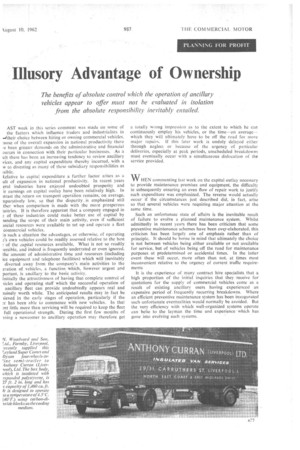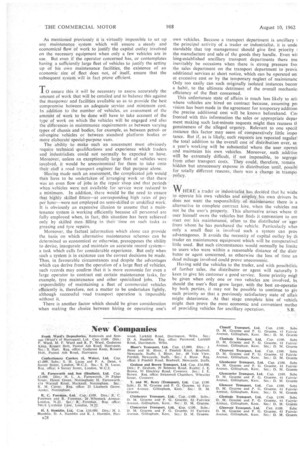Illusory Advantage of Ownership
Page 73

Page 74

If you've noticed an error in this article please click here to report it so we can fix it.
The benefits of absolute control which the operation of ancillary vehicles appear to offer must not be evaluated in isolation from the absolute responsibility inevitably entailed.
AST week in this Series Comment was made on some of the factors which influence traders and industrialists in —"their choice between hiring or owning commercial vehicles. :ause of the overall expansion in national productivity there te been greater demands on the administrative and financial Durces in connection with their particular businesses. As a ult there has been an increasing tendency to review ancillary vices, and any capital expenditure thereby incurred, with a w to divesting as many of these subsidiary responsibilities as ;si bk.
telative to capital expenditure a further factor arises as a ult of expansion in national productivity. In recent years eral industries have enjoyed undoubted prosperity and ir earnings on capital outlay have been relatively high. In itrast the return on transport opera-lion remains, on average, nparativety low, so that the disparity, is emphasized still ther when comparison is made with the more prosperous .ustries. It is therefore apparent that a company engaged in
of these industries could make better use of capital by )anding the scope of their main activity, even if sufficient ancial resources were available to set up and operate a fleet commercial vehicles.
:n such a situation the advantages, or otherwise, of operating es own vehicles could be readily assessed relative to the best of the zapital resources available. What is not so readily :essible, and indeed is frequently underrated or even ignored, the amount of administrative time and resources (including ice equipment and telephone facilities) which will inevitably diverted away from the company's main activities to the eration of vehicles, a function which, however urgent and portant, is ancillary to the basic activity.
Initially the attractiveness of having that complete control of iicles and operating staff which the successful operation of ancillary fleet can provide undoubtedly appears real and winely worth while. The anticipated results may in fact be iieved in the early stages of operation, particularly if the :r has been able to commence with new vehicles. In that !.nt littic more than servicing will be required to keep the fleet full operational strength. During the first few months of ming a newcomer to ancillary operation may therefore get a totally wrong impression as to the extent to which he can continuously employ his vehicles, or the time--on average-which they will ultimately have to be off the road for more major repairs. If this later work is unduly delayed either through neglect or because of the urgency of particular deliveries, especially at peak periods, unscheduled breakdowns must eventually occur with a simultaneous dislocation of the service provided.
HEN commenting last week on the capital outlay necessary to provide maintenance premises and equipment, the difficulty in subsequently ensuring an even flow of repair work to justify such expenditure was emphasized. The reverse would actually occur if the circumstances just described did, in fact, arise so that several vehicles were requiring major attention at the same time.
Such an unfortunate state of affairs is the inevitable result of failure to evolve a planned maintenance system. Whilst admittedly in recent years there has been criticism that some preventive maintenance schemes have been over-elaborated, this criticism has been largely one of emphasis rather than of principle. It should he borne in mind that ultimately the choice is not between vehicles being either available or not available for service, but of vehicles being off the road for maintenance purposes at predetermined or accidental times. In the latter event these will occur, more often than not, at times most inconvenient relative to the urgency of current traffic requirements It is the experience of many contract hire specialists that a high proportion of the initial inquiries that they receive for quotations for the supply of commercial vehicles come as a result of existing ancillary users having experienced an expensive period of frequently recurring breakdowns. Where an efficient preventive maintenance system has been inaugurated such unfortunate eventualities would normally be avoided. But the very efficiency with which well-organized systems operate can belie to the layman the time and experience which has gone into evolving such systems. As mentioned previously it is virtually impossible to set up any maintenance system which will ensure a steady and economical flow of work to justify the capital outlay involved on the necessary equipment when only a few vehicles are in use. But even if the operator concerned has, or contemplates having, a sufficiently large fleet of vehicles to justify the setting up of his own maintenance facilities, the existence of an economic size of fleet does not, of itself, ensure that the subsequent system will in fact prove efficient.
TO ensure this it will be necessary to assess accurately the amount of work that will be entailed and to balance this against the manpower and facilities available so as to provide the best compromise between an adequate service and minimum cost. In addition to the number of vehicles, an assessment of the amount of work to be done will have to take account of the type of work on which the vehicles will be engaged and also the differences in maintenance requirements as between varying types of chassis and bodies, for example, as between petrolor oil-engine vehicles or between standard platform bodies or more elaborate special-purpose vans. The ability to make such an assessment must obviously require technical qualifications and experience which traders and industrialists could not normally be expected to have. Moreover, unless an exceptionally large fleet of vehicles were involved, it would be uneconomical for them to take onto their staff a road transport engineer for that purpose alone.
Having made such an assessment, the complicated job would then have to be undertaken of 'arranging work so thatthere was an even flow of jobs in the repair shop and that periods when vehicles were not available for service were reduced to a minimum. In addition,' there would be the need to ensure that highly skilled fitters—at corresponding high rates of pay per hour—were not employed on semi-skilled or unskilled work. It is obviously an expensive illusion to assume that a maintenance system is working efficiently because all personnel are fully employed when, in fact, this situation has been achieved , only by skilled men filling in their time on such tasks as greasing and tyre repairs.
Moreover, the factual information which alone can provide the basis on which alternative maintenance schemes can be determined as economical or otherwise, presupposes the ability to devise, inaugurate and maintain an accurate record system— a task which calls for considerable experience. But only when such a system is in existence can the correct decisions be made. Thus, in favourable circumstances and despite the advantages which can derive from the operation of a large fleet of vehicles, such records may confirm that it is more economic for even a large operator to contract out certain maintenance tasks, for example, tyre maintenance and other specialized jobs. The responsibility of maintaining a fleet of commercial vehicles efficiently is, therefore, not a matter to be undertaken lightly, although successful road transport operation is impossible without it.
There is another factor which should be given consideration when making the choice between hiring or operating one's own vehicles. Because a transport department is ancillary 1 the principal activity of a trader or industrialist, it is unde standable that top management should give first priority the manufacture and sale of the goods they handle. Even wii long-established ancillary transport departments there mu inevitably be occasions when there is strong pressure fro] the sales department on the transport department to provi< additional services at short notice, which can be operated on at excessive cost or by the temporary neglect of maintenanc Only too easily can such originally isolated instances becorr a habit, to the ultimate detriment of the overall mechanic; efficiency of the fleet concerned.
This unfortunate state of affairs is much less likely to ad; where vehicles are hired on contract because, assuming pri vision has been made in the agreement for temporary addition the precise additional cost will be known beforehand. Col fronted with this information the sales or appropriate depar ment making such last-minute requests might then reassess tt genuineness of the alleged urgency. Relevant to one specif instance this factor may seem of comparatively little impo lance. But if, as is likely, such requests are repeated regular' the total addition to the overall cost of distribution over, sa a year's working will be substantial where the user operati and maintains his own vehicles. Moreover, such additioi will be extremely difficult, if not impossible, to segregal from other transport costs. They could, therefore, remain hidden but unnecessary expense in distribution until, possibl for totally different reasons, there was a change in transpo
WHERE a trader or industrialist has decided that he wish( to .operate his own vehicles and employ hiv own drivers bi does not want the responsibility.of maintenance there is a alternative to complete contract hire, when the vehicles ma not be the user's property. This alternative arises where tk. user himself owns the vehicles but finds it convenient to cot tract out his maintenance, often to the distributa or 'ager from whom he has purchased the vehicle. Particularly whet only a small fleet is involved such a system can pros, advantageous. It avoids the necessity of capital outlay by th trader on maintenance equipment which will be comparative] little used. But such circumstances would normally be limite to users who were within a reasonable distance of the distr hutor or agent concerned, as otherwise the loss of time an dead mileage involved could prove uneconomic.
Having sold the vehicles to the trader, and with possibilitk of further sales, the distributor or agent will naturally h keen to give his customer a good service. Some priority migt be given when only one or two vehicles are invoNed, bt should the user's fleet grow larger, with the best co-operatio by both parties, it may not be possible to continue to giv such priority so that a previously satisfactory state of affaii might deteriorate. At that stage complete hire of vehick might then prove the most economic and convenient metho of providing vehicles for ancillary operation. S.B,
















































































































